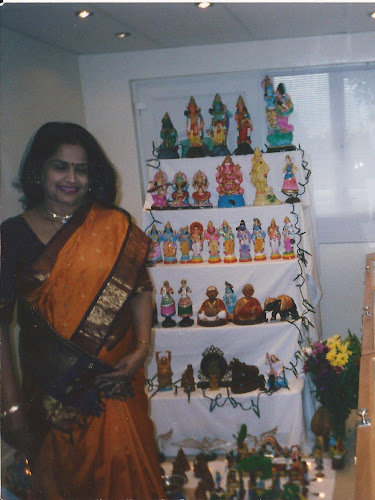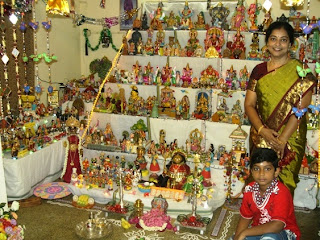
By London swaminathan
Nava Ratri, literally NINE NIGHTS, is the most popular festival among South Indian Hindu women. It is equally famous in Bengal where the last day of Nava Ratri is celebrated as Durga Puja. Dasara, literally ten day, is the biggest show in Karnataka.
Festivals similar to Navaratri were celebrated in different parts of the world including Japan, Rome and Greece. Indian temples are great centres of Arts. They were doing what Opera Houses are doing today in Sydney, London, Paris and New York. Even today South Indian Temples organise big music concerts and dance performances during Navaratri festival. Hindu women throng to temples during nine nights to see the illumination and decorations of temple idols.
In Tamil Nadu, Nava Ratri is a Toy and Doll Festival. They arrange toys in steps made up of wooden boxes or steps (look at the picture).
Doll Festival in Japan

Japanese celebrate a Doll Festival like Hindu Navaratri. It is celebrated every year on 3[SUP]rd[/SUP] March as Girl’s Day. Navaratri is celebrated as Girl’s Day In India too. Young girls who are called Kanyas receive special box or bag full of Tilak/Kumkum, Turmeric powder, Mirror, Comb, jewels etc. with fresh coconut, betel leaves, fruits and flowers. Girls are treated as representative of Goddess. Girls come dressed in their new clothes.
In Japan they arrange dolls like Hindus arrange clay toys, dolls and other items. Japanese spread a red cloth on the steps and arrange the dolls. This festival is called Hina Matsuri (Girl’s Day). In India, the dolls represent mythological characters, shop owner (Chettiyar/shresti/Bania)with his saleable items, kings, national leaders, saints, musicians and ordinary men. In Japan they arrange the dolls of emperor, empress, servants and musicians.
Japanese have been celebrating this for over one thousand years. Indians have been celebrating it from time immemorial. Japanese started this as river festival of floating reed toys. Then they changed it to arranging dolls at home. It started after the spread of Buddhism. India might have influenced them in this matter. Japanese celebrate it for health and happiness of the girls. They also make special snacks like Hindus. They also invite friends to their houses and give them food.
In short we see amazing similarities in three things: 1) Arranging dolls on steps 2) Celebrating as girl’s/women’s day 3) Inviting girls home and giving them special food and gifts.
Hindus see God in everything, whether it is music or dance or drawing (Rangoli,Henna) or Food (Prasad. So Hindu Navaratri is more of a religious festival where as Japanese and Greek celebrations are more of secular things.
Nine Muses in Greece
Greeks have also chosen Goddesses for the arts and poetry like Hindus.
The Muses are the nine goddesses of the arts, history and astronomy in Greece. The muses were not highlighted in mythologies, but writers and poets invoke them like Hindus before writing a book or performing dance and music. They are the source of inspiration for them like Goddess of Knowledge Saraswati or Goddess of wisdom, Ganesh.
Muses were among the retinue of the god Apollo, the patron of music and the arts. They were said to reside on Mount Helicon near Thebes or on Mount Parnassus near Delphi (Like Kailash or Mount Meru of Hindu Mythology).
Their names and branches of arts they preside over are as follows:
Name Meaning Arts
Calliope Beautiful voice Epic Poetry
Clio Fame History
Erato Lovely Lyric Poetry
Euterpe Joy The Flute
Melpomene Singing Tragic Drama
Polyhymnia Many Songs Mime
Terpsichore Joyful dance Dance
Thalia Good Cheer/Plenty Comic Drama
Urania Celestial Astronomy
Though we don’t see many similarities between these Gods and Hindu Gods, each Hindu artiste worships different gods for different arts: e.g Sculptors-Viswakarma, Flutists –Krishna, Dance- Nataraja/Shiva and Poets-Saraswati.
Hindu Goddess is worshipped as Kumarika, Trimurthy, Kalyani, Rohini, Kali, Chandika, Sambavi, Durga and Sambadra during nine nights in north india.
Hindu women in South India divide the nine nights in to three X three (3X3) and allocate them to Lakshmi, Saraswati and Durga. In Bengal they worship Goddesses in different forms. South Indian temples decorate Goddesses in nine different ways during nine nights. If we go deeper we may see more similarities. But Romans and Greeks keep them in museums nowadays, where as Hindus keep them in temples and continue the tradition.
Hindu women make snacks with boiled pulses such as Channa dhal, Bengal gram, green gram or black gram, peas, peanuts etc and distribute them to the visitors.
Vijayanagara kings celebrated Navaratri on a grand scale. Coorg people celebrate Dasara with great enthusiasm.
For more of the same, contact [email protected] or [email protected]

Picture: Kolu in India
Please read other posts by London Swaminathan on
1)Bull Fighting from Indus Valley to Spain via Tamil Nadu
2)Sugarcane Mystery: From Ikshvaku Dynasty to Indus Valley
3)Vedic Bird Homa in India and Iran
4)Sahasralinga in Karnataka and Cambodia
5)Delphi Oracle and Tamil oracles (In Tamil)
6)Naga –Mayan similarities (3 parts in Tamil)
7)Serpent Queen in Indus Valley and Minoan
8)Tamil Words in Greek ( 3 parts in Tamil)
9)Madagascar-India link via Indonesia
****************
